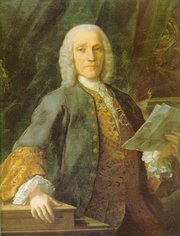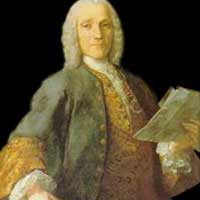Domenico Scarlatti - Biography
Domenico Scarlatti Biography
Domenico Scarlatti (October 26, 1685 – July 23, 1757) was an Italian composer of the Baroque era. He was extremely influential in the development of keyboard music, especially in Spain, Portugal and England, through his highly idiosyncratic and individual style.

| Contents |
Life and career
Surprisingly little is known about Scarlatti's life apart from legends and anecdotes. He was born in Naples, Italy, the sixth of ten children. Most likely he first studied under his father, Alessandro Scarlatti; other composers who may have been his early teachers include Gaetano Greco, Francesco Gasparini, and Bernardo Pasquini, all of whom seem to have influenced his musical style.
He became a composer and organist at the royal chapel in Naples in 1701, and in 1704, he revised Pollaroli's opera Irene for performance at Naples. Soon after this his father sent him to Venice, but the four years there are a blank in the record. In 1709 he went to Rome in the service of the exiled Polish queen Maria Casimira; while in Rome he met Thomas Roseingrave who would later lead the enthusiastic reception of the composer's sonatas in London. Domenico was already a harpsichord-player of eminence, and there is a story that at a trial of skill with George Friderich Handel at the palace of Cardinal Ottoboni in Rome he was adjudged perhaps superior to Handel on that instrument, although inferior on the organ. Later in life, he was known to cross himself in veneration, when speaking of Handel's skill.
Also while in Rome, Scarlatti composed several operas for Queen Casimira's private theatre. He was maestro di cappella at St Peter's from 1715 to 1719, and in the latter year came to London to direct his opera Narciso at the King's Theatre.
In 1720 or 1721 he went to Lisbon, where he taught music to the princess Maria Magdalena Barbara. He was at Naples again in 1725, but in 1729 went to Madrid as music master to the princess, who had married into the Spanish royal house. He remained in Spain for some twenty-five years. Maria Barbara became Queen of Spain. During this time he composed over five hundred keyboard sonatas. It is for these works that he is best remembered today.
Domenico Scarlatti died in Madrid, aged 71.
Music
Only a tiny fraction of this output was published in the composer's lifetime; Scarlatti himself seems to have overseen the publication in 1738 of the most famous collection, a book of 30 'Essercizi'. These were rapturously received throughout Europe; they seem to have influenced J. S. Bach's Goldberg Variations and were championed by the foremost English writer on music of the eighteenth century, Dr. Charles Burney. Scarlatti's influence on late-eighteenth style was therefore probably considerable, although he has always tended to be written into music history as an 'outsider'. The reasons for this may be due to generalizations about epochs (Baroque/Classical) or perhaps due to nationalistic tensions: Spain is almost off the map of most art-music histories, while Italy is seen as the land of opera. Unfortunately for Scarlatti, instrumental music is typically seen as, in the words of the Russian pianist Anton Rubinstein, 'A German Art'.
The Essercizi, however, did not reveal the full scope of Scarlatti's style: they are strikingly conservative when compared to his keyboard output as a whole. The mass of sonatas which were unpublished during the composer's lifetime have only appeared in print in fits and starts in the two and a half centuries since, and the repertoire is by no means well-understood today. Bizarrely, the Essercizi still dominate recital programmes. Scarlatti has, however, attracted notable admirers, including Chopin, Brahms, Heinrich Schenker and Vladimir Horowitz. The Russian school of pianism has always championed the sonatas.
The sonatas' technical difficulties have often caused them to be regarded as mere studies in virtuosity, and modern pianoforte technique owes much to their influence. They display a harmonic audacity, and adventurous use of modulation (changing from one key to another), a freshness and variety of invention and a vigorous intellectuality in thematic and structural terms which belies their 'popular' tone and their apparently careless appearance on the page. Above all, perhaps, Scarlatti's sonatas reveal a knack for the musical mot juste similar to that in Gershwin or Mozart.
Scarlatti sonata Recordings
- Scott Ross, complete edition, harpsichord, 34 CDs
- Scott Ross, highlights from the above, harpsichord
- Ralph Kirkpatrick, several recitals, harpsichord
- Gustav Leonhardt, several recitals, harpsichord
- Vladimir Horowitz, recital, piano
- Mikhail Pletnev, recital, piano, 2 CDs
- Ivo Pogorelich, recital, piano
- Szokolay Balazs, recital, piano
Literature
- Ralph Kirkpatrick, Domenico Scarlatti. Princeton University Press, 1953. (ISBN 0691027080)
External links
- John Sankey — Harpsichordist to the Internet (http://www.sankey.ws/harpsichord.html)
- Sheet music for K1 to K176 (http://www.sankey.ws/scarlattimus.html)
- Keyboard Tuning of Domenico Scarlatti (http://www.sankey.ws/consonance.html)
- Complete edition, harpsichord, downloadable recordings in MIDI (http://www.sankey.ws/scarlattirec.html)
- Piano Society - Scarlatti (http://www.pianosociety.com/index.php?id=52) - A short biography and some free recordings in MP3 format.
This biography is published under the GNU Licence
